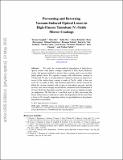Preventing and reversing vacuum-induced optical losses in high-finesse tantalum (V) oxide mirror coatings
Author(s)
Gangloff, Dorian; Shi, Molu; Wu, Tailin; Bylinskii, Alexei; Braverman, Boris; Nichols, Rosanna; Li, Junru; Aichholz, Kai; Cetina, Marko; Karpa, Leon; Gutierrez, Michael Steven; Jelenkovic, Branislav; Vuletic, Vladan; Chuang, Isaac L.; ... Show more Show less
DownloadChuang_Preventing and.pdf (511.0Kb)
OPEN_ACCESS_POLICY
Open Access Policy
Creative Commons Attribution-Noncommercial-Share Alike
Terms of use
Metadata
Show full item recordAbstract
High-finesse optical cavities placed under vacuum are foundational platforms in quantum information science with photons and atoms. We study the vacuum-induced degradation of high-finesse optical cavities with mirror coatings composed of SiO[subscript 2]-Ta[subscript 2]O[subscript 5] dielectric stacks, and present methods to protect these coatings and to recover their initial low loss levels. For separate coatings with reflectivities centered at 370 nm and 422 nm, a vacuum-induced continuous increase in optical loss occurs if the surface-layer coating is made of Ta[subscript 2]O[subscript 5], while it does not occur if it is made of SiO[subscript 2]. The incurred optical loss can be reversed by filling the vacuum chamber with oxygen at atmospheric pressure, and the recovery rate can be strongly accelerated by continuous laser illumination at 422 nm. Both the degradation and the recovery processes depend strongly on temperature. We find that a 1 nm-thick layer of SiO[subscript 2] passivating the Ta[subscript 2]O[subscript 5] surface layer is sufficient to reduce the degradation rate by more than a factor of 10, strongly supporting surface oxygen depletion as the primary degradation mechanism.
Date issued
2015-07Department
Massachusetts Institute of Technology. Department of Electrical Engineering and Computer Science; Massachusetts Institute of Technology. Department of Physics; Massachusetts Institute of Technology. Research Laboratory of Electronics; MIT-Harvard Center for Ultracold AtomsJournal
Optics Express
Publisher
Optical Society of America
Citation
Gangloff, Dorian, Molu Shi, Tailin Wu, Alexei Bylinskii, Boris Braverman, Michael Gutierrez, Rosanna Nichols, et al. “Preventing and Reversing Vacuum-Induced Optical Losses in High-Finesse Tantalum (V) Oxide Mirror Coatings.” Optics Express 23, no. 14 (2015): 18014.
Version: Original manuscript
ISSN
1094-4087